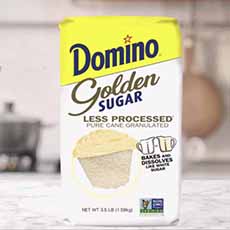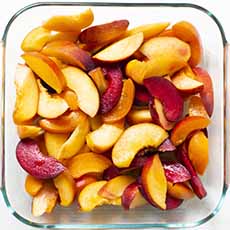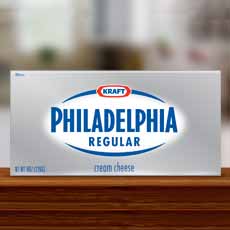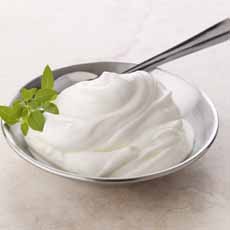RECIPE: Peaches & Cream Cheesecake For National Peaches & Cream Day
|
|
National Cheesecake Day is July 30th. National Peaches & Cream Day is June 21st. How about combining a celebration with this delicious Peaches & Cream Cheesecake? While fresh peaches with heavy cream or peach ice cream are two of our favorites, the folks at Domino Sugar created this yummy recipe with its new Domino® Golden Sugar (photo #3). See more about it below. This recipe has a nut topping. If you don’t want nuts, you can omit a topping, or make additional peach puree. You can also dot the top with peach jam. Prep time is 15 minutes, cook time is 1 hour 10 minutes. Ingredients For The Crust 1. MAKE the crust. Set a rack to the middle of the oven and preheat the oven to 350°F. Lightly spray an 8-inch springform pan with nonstick cooking spray. Wrap the bottom and sides of the springform pan in foil to prevent leakage. 2. COMBINE in a medium bowl graham cracker crumbs, butter and sugar; stir to moisten crumbs. Press the crust into the bottom and slightly up the sides of the springform pan. 3. BAKE in the center of oven for 6 minutes or until the crumbs just begin to brown. Remove from the oven and cool. Leave the oven on. 4. MAKE the filling. Purée the peaches in mini food processor until smooth. Divide in half and set aside. 5. BEAT the cream cheese in mixer bowl on medium speed. Gradually add the sugar and beat until smooth. Add eggs, one at a time; beat until light and whipped. 6. BEAT in the vanilla, sour cream, and puréed peaches; then, stir in flour. Pour the mixture onto the prepared crumb crust. Set the pan on a baking sheet with sides. 7. SET the baking sheet on the middle rack of the oven and pour 1/2 inch of hot water onto the baking sheet (the steam created from the water bath [bain-marie] will prevent the cheesecake top from cracking). Then, carefully push the rack in and close oven door. 8. BAKE for 10 minutes, then reduce oven temperature to 325°F. Bake for 1 hour or until set. The cheesecake is done when a knife inserted in the center comes out clean. The cake should still jiggle a bit when moved. 9. REMOVE from the oven and from the water bath and cool 45 minutes to one hour. Cover and chill until ready to serve. 10. MAKE the glazed pecan topping— Whisk sugar, cornstarch, and water together in a sauce pot over medium heat and bring to a boil. Fold in reserved peach puree and peach slices, bring mixture back to a boil, stirring constantly; then, reduce heat and simmer 1 to 2 minutes or until sauce is thickened and translucent. Do not overcook the peaches. Stir in lemon juice, remove from heat, and cool. Chill until ready to serve. To serve, arrange cooked peaches decoratively over top of cheesecake, allowing sauce to drip down the sides. For people who want less processed food products, Domino Golden Sugar is made with a proprietary process, to be less processed than granulated white sugar, but without compromising performance or taste. The reason it’s less processed is because Domino Golden Sugar does not undergo color removal as does white sugar. Instead, it retains a hint of molasses that results in a beautiful golden color and less processing than granulated white sugar. The process of producing granulated white sugar consists of seven steps after obtaining raw sugarcane juices, whereas the process of producing Golden Sugar is only three steps—clarification, crystallization and drying. Compared with Domino Soft Brown Sugar and other brown sugars, Domino Golden Sugar is free-flowing like white granulated sugar. Brown sugar varieties retain much more moisture and are not free-flowing. Domino® Soft Brown Sugar has a darker color and heavier molasses flavor than Domino Golden Sugar. For more information on Domino Golden Sugar visit DominoSugar.com. |
|
|
THE HISTORY OF PEACHES The peach originated in China and has been cultivated at least since 1000 B.C.E. It took some persistence on the part of the farmers to develop the luscious modern peach: The wild fruit is small, sour and very fuzzy. The peach has special significance in Chinese culture: The peach tree is considered to be the tree of life and peaches are symbols of immortality and unity. Peach blossoms are carried by Chinese brides. Peaches traveled west via the silk roads to Persia, earning them the botanical name Prunus persica. ________________ *Pêche (French), Pfirsich (German), pesca (Italian), melocotón (Spanish), pêssego (Portuguese), fersken (Danish/Norwegian), persika (Swedish), persikka (Finnish), persik (Russian), brzoskwinia (Polish), breskva (Serbo-Croat), piersica (Romanian), praskova (Bulgarian), robakinon (Greek), seftali (Turkish), afarseq (Hebrew), khúkh (Arabic), hulu (Persian), arú (Hindi), tao (Chinese), momo (Japanese), persik (Indonesian). |
||









